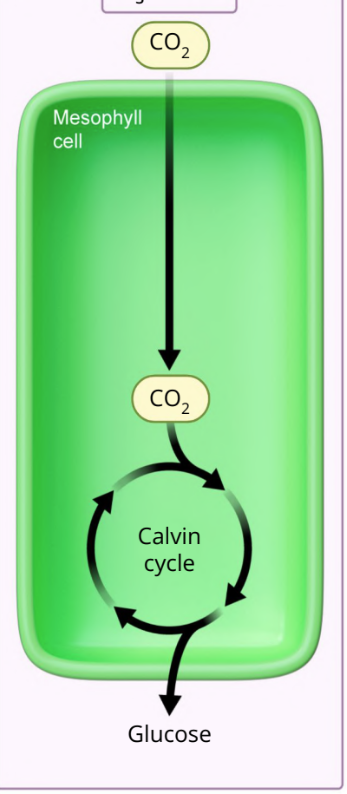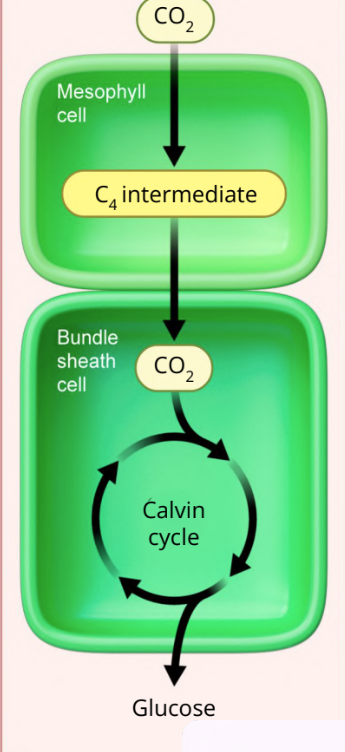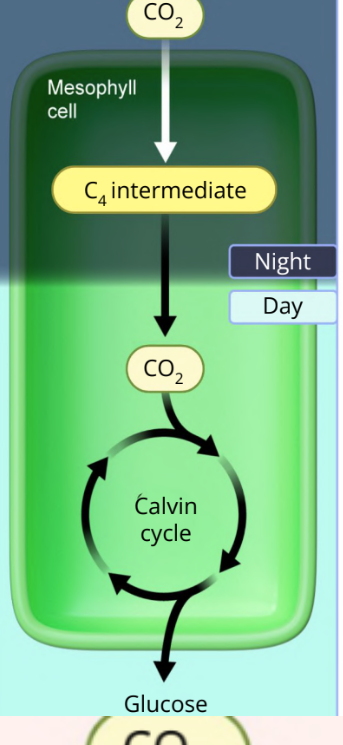Photosynthesis DAT Ch 4
1/55
Earn XP
Description and Tags
DAT Ch 4
Name | Mastery | Learn | Test | Matching | Spaced |
|---|
No study sessions yet.
56 Terms
Heterotrophs
must get energy from the food they eat
Autotrophs
make their own food
Photoautotrophs
use light energy to convert it to chemical energy using photosynthesis
Photosynthesis
process originally developed in cyanobacteria and reduces atmospheric carbon dioxide, releases oxygen, and creates chemical energy that can be transferred through food chains
Photons
light energy used to synthesize sugars in photosynthesis
Carbon Fixation
process by which inorganic carbon is converted into an organic molecule of glucose
Photolysis
releases electrons to be used in photosynthesis, process of splitting water molecules, excites them by using solar energy
Photosynthesis Spontaneity
non spontaneous and endergonic
Cellular Respiration Spontaneity
spontaneous and exergonic
Mesophyll Cells
between upper and lower epidermis of leaves, facilitate gas movement within the leaf, contain chloroplasts
Chloroplasts
organelle that carries out photosynthesis, found in plants and photosynthetic bacteria but not in cyanobacteria
Outer Membrane
Outer plasma membrane made of phospholipid bilayer
Intermembrane Space
Space between the outer and inner membranes
Inner membrane space
Inner membrane plasma made of phospholipid bilayer
Stroma
Fluid material that fills the area inside the inner membrane. Calvin cycle occurs here
Thylakoids
A membrane structure within the stroma. Multiple stack up to form a granum. They are the site of light dependent reactions
Thylakoid Lumen
Interior of the thylakoid, H+ ions accumulate here, making it acidic
Light dependent reactions
thylakoid membrane, harness light energy to produce ATP and NADPH, this ATP is NOT used to power the cell it is used to power the Calvin Cycle
NADPH
an electron carrier from Light dependent reaction to Calvin Cycle
Photosystems
special pigments such as chlorophyll, that absorb photons
Chlorophyll
absorbs red and blue light, reflects green light
Reaction Center
special pair of chlorophyll molecules in the center of these proteins
Chlorophyll Structure
porphyrin rings structure with a magnesium atom bound in its center, containing Photosystem II and Photosystem I that are used in photosynthesis
Non cyclic photophosphorylation
carried out by the light dependent reactions, with six steps
Step 1 of Non cyclic photophosphorylation
water is split (photolysis), passing electrons to Photosystem II and releasing protons into the the thylakoid lumen
Step 2 of Non cyclic photophosphorylation
Photons excite electrons in the reaction center of PS II, passing electrons to the primary electron accepter (NADPH)
Step 3 of Non cyclic photophosphorylation
Primary electron accepter sends the excited electrons to the electron transport chain during redox reactions, protons pump into the thylakoid lumen. Electrons deposited into the PS I
Step 4 of Non cyclic photophosphorylation
Photons excite pigments in PS I, energizing electrons int he reaction center to be passed to another primary electron acceptor
Step 5 of Non cyclic photophosphorylation
The electrons are sent to a short electron transport chain that terminates with NADP+ reductase
NADP+ reductase
enzyme that reduces NADP+ into NADPH using electrons and protons during step five of the non cyclic photophosphorylation
Step 6 of Non cyclic photophosphorylation
accumulation of protons in the thylakoid lumen generates an electrochemical gradient that is used to produce ATP using an ATP synthase, moving H+ into the stroma
Cyclic Photophosphorylation
Electrons from PS I are cycled back into the first ETC, increasing the amount of protons pumped into the Thylakoid lumen. Bypass NAD+ reductase so no NADPH is produced
Calvin Cycle
light independent reactions in the chloroplast stroma of plant mesophyll cells , use ATP and NADPH from light dependent reactions, fixes carbon dioxide that enters the leaves through the stomata
Stomata
pores in the epidermis of the leaves of a plant, closed in hot environments to minimize water loss and accumulate oxygen (photorespiration)
Carbon fixation (step 1)
carbon dioxide combines with five carbon (RuBP) to form six carbon molecules, which quickly break down into three carbon PGA, catalyzed by RuBisCo
Reduction (step 2)
PGA is phosphorylated by APT, then NADPH to form G3P
Regeneration (Step 3)
Most of G3P is converted back into RuBP
Carbohydrate Synthesis (Step 4)
Some of the G3P is used to make glucose
Calvin Cycle Reaction Formula
6Co2 +18ATP +12 NADPH +H+ → 18ADP + 18pi + 12 NADP+ + 1 Glucose
Photorespiration
produces two carbon phosphoglycerate and eventually converts it to PGA, there is a net loss of fixed carbon in the process and no new glucose is produced
RuBISCO
in addition to fixing carbon dioxide into RuBP, can also cause oxygen to bind to RuBP in a process called photorespiration
Alternate name for photorespiration
C2 Photosynthesis, since a two carbon molecule is produced (PGA)
Alternative Photosynthetic Pathways
C3 Photosynthesis, C4 Photosynthesis, and Crassulacean Acid Metabolism (CAM) Photosynthesis
C3 Photosynthesis
Normal photosynthesis, where three carbon PGA is produced
C4 Photosynthesis
produce a four carbon intermediate , uses spacial isolation of carbon dioxide to prevent photorespiration in plants living in hot environments
C4 Step 1
Co2 is fixed and produces a four carbon intermediate, oxaloacetate which is then converted into a second intermediate, malate in the mesophyll cells
C4 Step 2
Malate is transferred into the bundle sheath cells which have less oxygen
C4 Step 3
Malate is decarboxylated, spatially isolating Co2. It is then fixed by rubisco and enters the calvin cycle
CAM
Uses temporal isolation of carbon dioxide to prevent photorespiration in hot and dry environments
CAM Step 1
During the day the stomata are closed to prevent transpiration
Transpiration
evaporation of water from plants
CAM Step 2
During the night stomata open to let Co2 in, just as in C4, photosynthesis, Co2 is fixed, producing oxaloacetate. however malate is not shuttled to bundle sheaths
CAM Step 3
During the next day, the stomata are closed again and malate is decarboxylated. Co2 is temporally isolated from O2 which cannot enter during the day. Co2 is fixed by RuBIsCo and enter the Calvin Cycle
C3 Plants

C4 Plants

CAM plants
